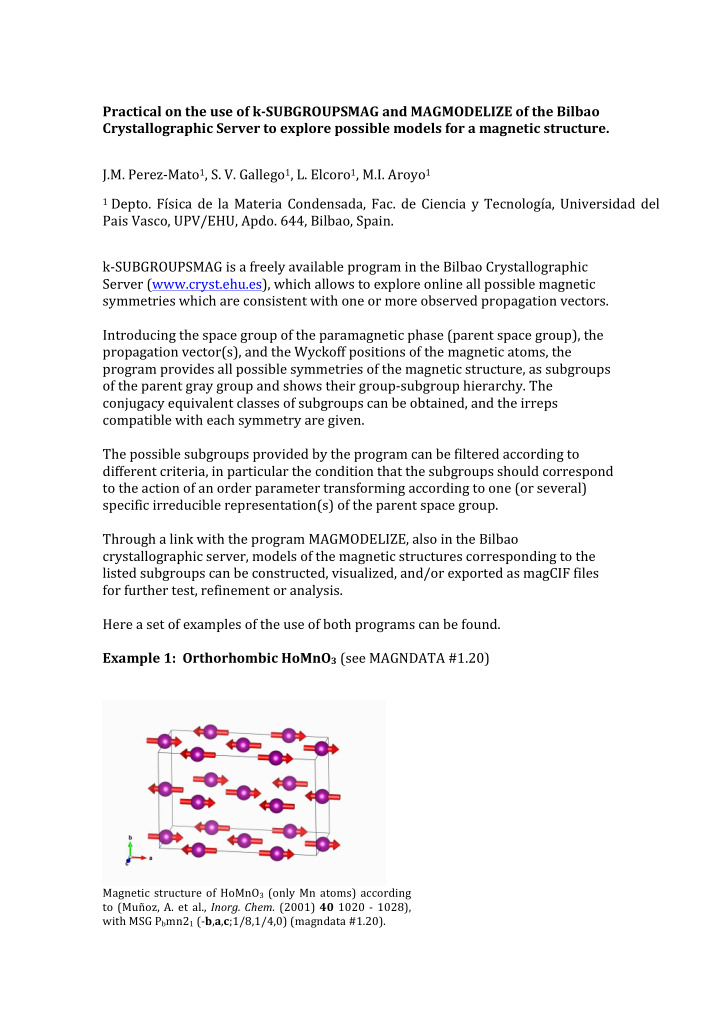



¡ Practical ¡on ¡the ¡use ¡of ¡k-‑SUBGROUPSMAG ¡and ¡MAGMODELIZE ¡of ¡the ¡Bilbao ¡ Crystallographic ¡Server ¡to ¡explore ¡possible ¡models ¡for ¡a ¡magnetic ¡structure. ¡ ¡ J.M. ¡Perez-‑Mato 1 , ¡S. ¡V. ¡Gallego 1 , ¡L. ¡Elcoro 1 , ¡M.I. ¡Aroyo 1 ¡ 1 ¡ Depto. ¡Física ¡de ¡la ¡Materia ¡Condensada, ¡Fac. ¡de ¡Ciencia ¡y ¡Tecnología, ¡Universidad ¡del ¡ Pais ¡Vasco, ¡UPV/EHU, ¡Apdo. ¡644, ¡Bilbao, ¡Spain. ¡ ¡ k-‑SUBGROUPSMAG ¡is ¡a ¡freely ¡available ¡program ¡in ¡the ¡Bilbao ¡Crystallographic ¡ Server ¡(www.cryst.ehu.es), ¡which ¡allows ¡to ¡explore ¡online ¡all ¡possible ¡magnetic ¡ symmetries ¡which ¡are ¡consistent ¡with ¡one ¡or ¡more ¡observed ¡propagation ¡vectors. ¡ ¡ ¡ Introducing ¡the ¡space ¡group ¡of ¡the ¡paramagnetic ¡phase ¡(parent ¡space ¡group), ¡the ¡ propagation ¡vector(s), ¡and ¡the ¡Wyckoff ¡positions ¡of ¡the ¡magnetic ¡atoms, ¡the ¡ program ¡provides ¡all ¡possible ¡symmetries ¡of ¡the ¡magnetic ¡structure, ¡as ¡subgroups ¡ of ¡the ¡parent ¡gray ¡group ¡and ¡shows ¡their ¡group-‑subgroup ¡hierarchy. ¡The ¡ conjugacy ¡equivalent ¡classes ¡of ¡subgroups ¡can ¡be ¡obtained, ¡and ¡the ¡irreps ¡ compatible ¡with ¡each ¡symmetry ¡are ¡given. ¡ ¡ The ¡possible ¡subgroups ¡provided ¡by ¡the ¡program ¡can ¡be ¡filtered ¡according ¡to ¡ different ¡criteria, ¡in ¡particular ¡the ¡condition ¡that ¡the ¡subgroups ¡should ¡correspond ¡ to ¡the ¡action ¡of ¡an ¡order ¡parameter ¡transforming ¡according ¡to ¡one ¡(or ¡several) ¡ specific ¡irreducible ¡representation(s) ¡of ¡the ¡parent ¡space ¡group. ¡ ¡ Through ¡a ¡link ¡with ¡the ¡program ¡MAGMODELIZE, ¡also ¡in ¡the ¡Bilbao ¡ crystallographic ¡server, ¡models ¡of ¡the ¡magnetic ¡structures ¡corresponding ¡to ¡the ¡ listed ¡subgroups ¡can ¡be ¡constructed, ¡visualized, ¡and/or ¡exported ¡as ¡magCIF ¡files ¡ for ¡further ¡test, ¡refinement ¡or ¡analysis. ¡ ¡ ¡ Here ¡a ¡set ¡of ¡examples ¡of ¡the ¡use ¡of ¡both ¡programs ¡can ¡be ¡found. ¡ ¡ ¡ Example ¡1: ¡ ¡Orthorhombic ¡HoMnO 3 ¡ (see ¡MAGNDATA ¡#1.20) ¡ ¡ ¡ ¡ ¡ Magnetic ¡structure ¡of ¡HoMnO 3 ¡(only ¡Mn ¡atoms) ¡according ¡ to ¡(Muñoz, ¡A. ¡et ¡al., ¡ Inorg. ¡Chem. ¡(2001) ¡ 40 ¡1020 ¡-‑ ¡1028), ¡ with ¡MSG ¡P b mn2 1 ¡(-‑ b , a , c ;1/8,1/4,0) ¡(magndata ¡#1.20). ¡
¡ The ¡paramagnetic ¡structure ¡of ¡ ¡HoMnO 3 ¡can ¡be ¡summarized ¡as ¡(Muñoz, ¡A. ¡et ¡al., ¡ Inorg. ¡ Chem. ¡(2001) ¡ 40 ¡1020 ¡-‑ ¡1028): ¡ Space ¡group: ¡Pnma ¡(#62) ¡ Lattice ¡parameters: ¡ 5.83536 ¡7.36060 ¡5.25722 ¡ ¡ Asymmetric ¡unit: ¡ Ho1 ¡-‑ ¡0.08390 ¡0.25000 ¡0.98250 ¡ Mn1 ¡-‑ ¡0.00000 ¡0.00000 ¡0.50000 ¡ O1 ¡-‑ ¡0.46220 ¡0.25000 ¡0.11130 ¡ O2 ¡-‑ ¡0.32810 ¡0.05340 ¡0.70130 ¡ ¡ ¡ This ¡case ¡is ¡also ¡used ¡as ¡an ¡example ¡in ¡a ¡the ¡tutorial ¡that ¡we ¡prepared ¡for ¡the ¡ program ¡MAXMAGN. ¡Here ¡we ¡can ¡see ¡the ¡additional ¡possibilities ¡that ¡k-‑ SUBGROUPSMAG ¡provides. ¡ ¡ a) ¡Introduce ¡the ¡parent ¡space, ¡the ¡propagation ¡vector ¡and ¡the ¡Mn ¡Wyckoff ¡ position ¡(4b) ¡in ¡the ¡first ¡input ¡pages ¡of ¡k-‑SUBGROUPSMAG , ¡ ¡and ¡derive ¡the ¡ graph ¡of ¡all ¡magnetic ¡subgroups ¡(conjugate ¡classes) ¡consistent ¡with ¡the ¡observed ¡ propagation ¡vector, ¡and ¡check ¡that ¡apart ¡from ¡the ¡monoclinic ¡k-‑maximal ¡ subgroups ¡there ¡is ¡only ¡a ¡third ¡possible ¡centrosymmetric ¡symmetry, ¡namely ¡a ¡ subgroup ¡of ¡type ¡P s -‑1, ¡which ¡a ¡common ¡subgroup ¡of ¡the ¡two ¡centrosymmetric ¡ monoclinic ¡groups ¡of ¡maximal ¡symmetry ¡(Figure ¡1). ¡ ¡ ¡ ¡ ¡ ¡ ¡ ¡ ¡ ¡
Figure ¡1. ¡ Output ¡page ¡of ¡k-‑SUBGROUPSMAG ¡showing ¡the ¡group-‑subgroup ¡hierarchy ¡of ¡all ¡possible ¡ magnetic ¡symmetries ¡of ¡a ¡magnetic ¡ordering ¡for ¡a ¡paramagnetic ¡structure ¡with ¡space ¡group ¡Pnma ¡ and ¡a ¡propagation ¡vector ¡(1/2 ¡0 ¡0) ¡(the ¡condition ¡of ¡the ¡magnetic ¡site ¡to ¡be ¡4b, ¡does ¡not ¡produce ¡ any ¡further ¡restriction ¡on ¡the ¡possible ¡subgroups) ¡. ¡Only ¡the ¡BNS ¡label ¡of ¡the ¡corresponding ¡group ¡ type ¡is ¡indicated. ¡The ¡k-‑maximal ¡magnetic ¡groups ¡are ¡highlighted ¡with ¡elliptical ¡frames. ¡Only ¡one ¡ subgroup ¡per ¡conjugate ¡class ¡is ¡shown. ¡Except ¡for ¡the ¡two ¡monoclinic ¡k-‑maximal ¡subgroups ¡and ¡its ¡ common ¡subgroup ¡Ps-‑1, ¡all ¡other ¡possible ¡symmetries ¡are ¡polar ¡and ¡allow ¡an ¡induced ¡electric ¡ polarization. ¡ ¡ ¡ The ¡numbers ¡below ¡the ¡label ¡of ¡each ¡conjugate ¡class ¡allows ¡to ¡identify ¡the ¡class ¡in ¡ the ¡listing ¡provided ¡by ¡the ¡program ¡(Figure ¡2). ¡These ¡numbers ¡can ¡be ¡removed ¡to ¡ obtain ¡a ¡tidier ¡figure. ¡The ¡ouput ¡page ¡includes ¡several ¡menus ¡to ¡manipulate ¡the ¡ graph, ¡restricting ¡its ¡extent. ¡ ¡ ¡ ¡ Figure ¡2. ¡ List ¡provided ¡by ¡k-‑SUBGROUPSMAG ¡of ¡all ¡possible ¡magnetic ¡symmetries ¡of ¡a ¡magnetic ¡ ordering ¡for ¡a ¡paramagnetic ¡structure ¡with ¡space ¡group ¡Pnma ¡and ¡a ¡propagation ¡vector ¡(1/2 ¡0 ¡0) ¡ (the ¡condition ¡of ¡the ¡magnetic ¡site ¡to ¡be ¡4b, ¡does ¡not ¡produce ¡any ¡further ¡restriction ¡on ¡the ¡ possible ¡subgroups) ¡. ¡Only ¡the ¡BNS ¡label ¡of ¡the ¡corresponding ¡group ¡type ¡is ¡indicated. ¡The ¡k-‑ maximal ¡magnetic ¡groups ¡are ¡highlighted ¡with ¡elliptical ¡frames. ¡Only ¡one ¡subgroup ¡per ¡conjugate ¡ class ¡is ¡shown. ¡By ¡clicking ¡on ¡the ¡button ¡“conjugacy ¡class” ¡a ¡list ¡of ¡all ¡distinct ¡subgroups ¡belonging ¡ to ¡the ¡conjugacy ¡class ¡is ¡shown. ¡The ¡button ¡“Get ¡irreps” ¡is ¡a ¡direct ¡link ¡to ¡the ¡program ¡Get_mirreps, ¡ which ¡allows ¡to ¡obtain ¡all ¡the ¡irreps ¡of ¡the ¡parent ¡space ¡group ¡that ¡are ¡compatible ¡with ¡listed ¡ subgroup ¡of ¡the ¡gray ¡parent ¡group. ¡The ¡last ¡column ¡allows ¡to ¡choose ¡those ¡symmetries ¡that ¡one ¡ wants ¡to ¡transmit ¡to ¡MAGMODELIZE ¡for ¡further ¡analysis ¡of ¡the ¡corresponding ¡magnetic ¡structure ¡ models. ¡ ¡ b) ¡Check ¡the ¡button ¡“more ¡options” ¡on ¡the ¡page ¡with ¡the ¡list ¡or ¡with ¡the ¡ graph ¡of ¡the ¡possible ¡subgroups ¡(conjugacy ¡classes) . ¡This ¡gives ¡the ¡possibility ¡ to ¡further ¡filter ¡the ¡possible ¡magnetic ¡symmetries ¡with ¡the ¡condition ¡of ¡allowing ¡a ¡
Recommend
More recommend